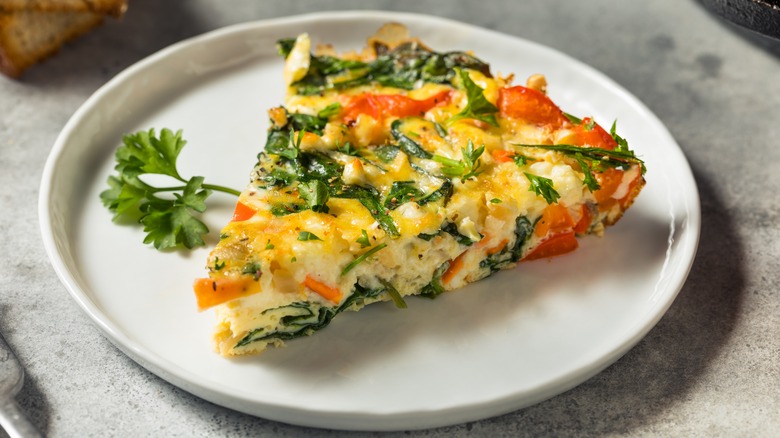The Easy Way To Tell When Your Frittata Is Done
Whether you're whipping up brunch on the weekend, having a breakfast-for-dinner craving, or just need to use up those extra vegetables in the fridge, a frittata is always a go-to. It's an egg-celent source of protein, easy to whip up, and yet elegant enough to make you look like a pro. Think about it; it's just eggs and whatever mix-ins you want. However, let's set the record straight: a frittata and a quiche are not the same things. Nevertheless, they're both delicious in their own unique ways and are pretty much glorified omelets, yet very different (per Food52).
In fact, Kitchen Project states that a frittata is actually often called an Italian omelet, and the word "frittata" actually translates to "friggere," which is the Italian verb meaning "to fry." While it does start out on the stovetop for a quick crust, it's eventually finished in the oven for the eggs to set. However, judging when the eggs are cooked but not overcooked is quite a difficult task. It's not like you can stick a toothpick in it like you would a cake, so what's the easy solution?
It should jiggle slightly
With frittatas using both the stovetop and the oven, it makes it more difficult to know when to move from the stove to the oven and from the oven to the counter to cool. The stovetop isn't where most of the magic happens, so it's very important that the pan is over a gentle flame to start. The Kitchn recommends cooking it over medium-low heat or low heat and transferring it to the oven as soon as the edges are set. This allows the bottom to form a solid crust without browning it too much. From there, it's time to do the jiggle test...
According to MyRecipes, once the frittata has made its way to the oven, not only should you keep a close eye on it, but you can determine its doneness by how much it jiggles. It shouldn't be as jiggly as a creme brulee, but if it's stiff, it's overcooked. The cast iron pan will continue to cook the frittata after it is removed from the oven, so when it's ready to be pulled and served, the top should still have a slight jiggle.

